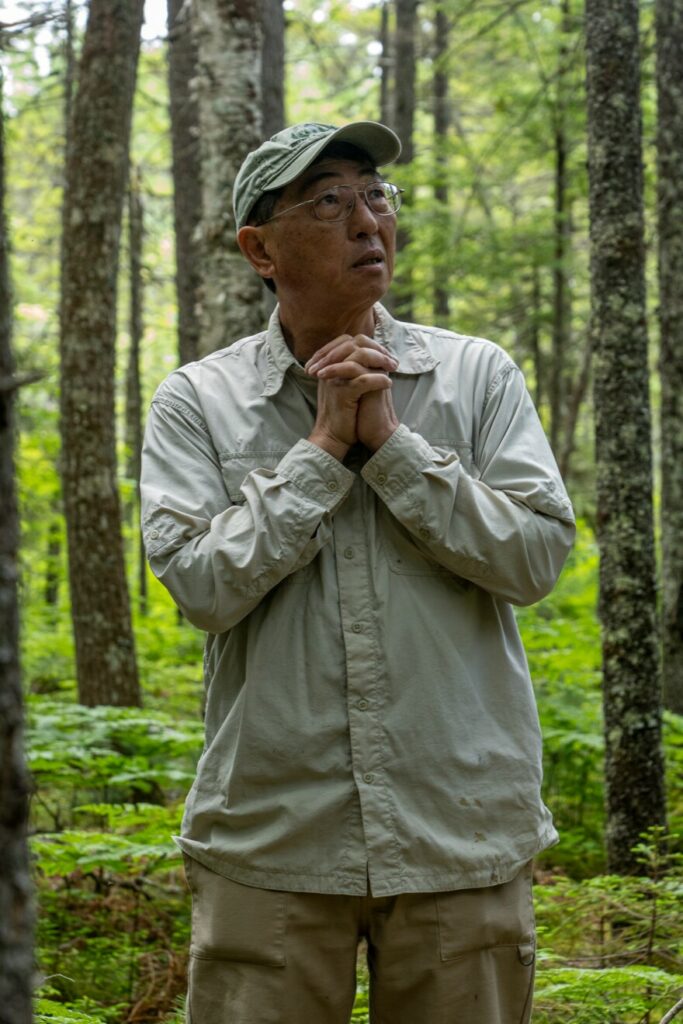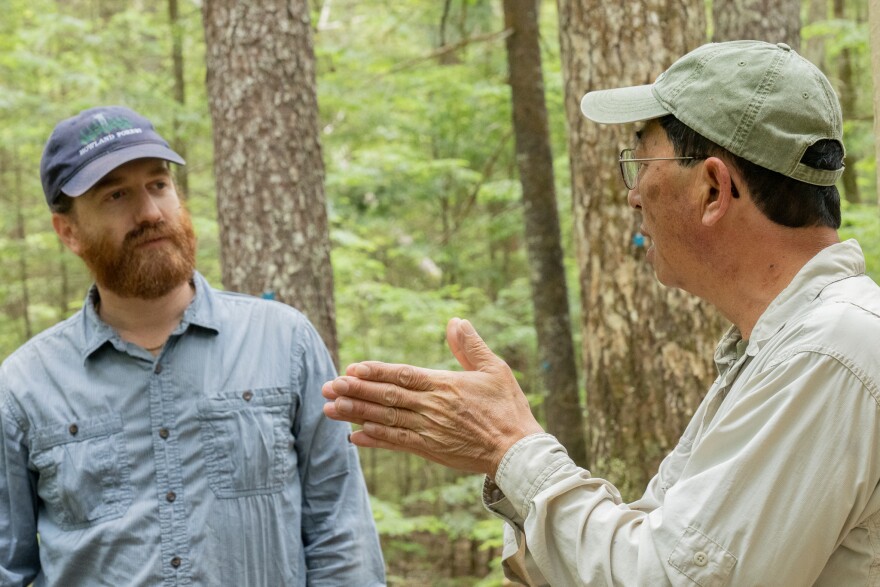A Maine forest offers decades of data on trees’ ability to remove carbon from the air
For decades, scientists from around the world have been visiting a mature forest just off the interstate, about 30 miles north of Bangor.
They’ve undertaken groundbreaking studies on acid rain, forest ecology and soil health. NASA used it for a remote sensing project. And at one point the 550-acre Howland Research Forest was the most photographed place on the planet — from space.
On top of all that, Howland’s best-kept secret is one of the longest, continuous records of atmospheric carbon and of the role forests play in the fight against climate change.
This story is part of Maine Public’s series “Climate Driven: A deep dive into Maine’s response, one county at a time.”
At the research forest, carbon and other greenhouse gas measurements are continuously recorded from the top of several meteorological towers that soar above a lush canopy of spruce, hemlock and white pine.

John Lee (right), a University of Maine research associate who manages the Howland Research Forest, at the top of its main research tower with Maine Public’s Susan Sharon. (Kris Bridges)
UMaine research associate John Lee has been managing the forest for more than 25 years. He’s comfortable climbing the main tower which has a series of internal metal ladders and narrow platforms spaced six feet apart. Wearing safety harnesses, visitors like a Maine Public reporter are allowed to join him on the climb for the bird’s eye view at the top.
“This tower is 88-feet tall,” Lee says on the climb. “So, take your time as you go up. It’s certainly not a race. Don’t do anything you’re not comfortable with.”
Lee says when atmospheric carbon dioxide was first measured here in the mid-1990s, it was at about 359 parts per million. Now, it’s well over 400 parts per million. That increasing level is widely recognized as something that could make human-caused global warming even worse.

John Lee, a research associate at the University of Maine who has managed the Howland Research Forest for 25 years. (Kris Bridges)
“You know the climb has been steady,” he says. “And is pretty much the same as other measurement sites around the world.”
Lee and other researchers are especially interested in carbon flux. That’s the exchange of carbon between the atmosphere and, in this case, the forest. They can measure what’s going in and what’s going out as part of a natural cycle.
“We can calculate fluxes of anything we can measure in the atmosphere. Carbon, of course, is the constituent of most interest because it is the most common greenhouse gas,” he says.
And trees, it turns out, offer the best carbon capture technology in the world. During photosynthesis, they pull carbon out of the air and store it. When they decompose, the carbon is gradually released.
Younger trees are adept at rapidly absorbing carbon. But don’t count the old trees out, says Dave Hollinger, a plant physiologist with the U.S. Forest Service. They’re good at storing it.
The average tree stand in the Howland Forest is 140-years old. And Hollinger says research done here shows older trees are able to pack in large amounts of carbon despite the changing climate.
“Since we’ve been measuring the forest over the past 25, 26 years now, Maine has seen the warmest, wettest and driest conditions that exist in the 125-year record of climate measurements in Maine. And throughout all of these extremes the forest has continued to take up carbon from the atmosphere,” Hollinger says. “In fact, over that 25 years the rate of uptake has actually increased.”
Hollinger is the director of the Northeast Climate Hub, which shares climate change solutions with farmers and forest landowners. He’s also worked on carbon flux research at Howland and, for several years, was the lead scientist for a national network of similar sites called Ameriflux. He says it’s good news that forests can function this way.
“You could also call them carbon reserves,” Hollinger says. “And so the CO2 in the atmosphere is going up more slowly than it should otherwise based on all the fossil fuels that are getting consumed and that’s because forests globally are doing that.”
U.S. forests stored nearly 60 billion metric tons of carbon in 2020 according to the Environmental Protection Agency’s inventory. More than 90% was contained in the forest ecosystem, especially soils. The rest was in harvested wood products. And they collectively serve as a net carbon sink, absorbing more carbon out of the atmosphere than they release.
Jon Leibowitz is the executive director of the Northeast Wilderness Trust which purchased Howland Forest 15 years ago when it was at risk of being logged. Leibowitz says the Trust liked the old growth qualities of the forest for biodiversity, and for its role as a carbon sink.
“We’re talking about as a society, national climate solutions, and what we need to be thinking about for storing and sequestering the most amount of carbon,” Leibowitz says. “And there’s this really healthy debate going on between the old forests and the young forests and managed versus unmanaged. Our perspective at Northeast Wilderness Trust is that it’s an ‘all-of-the-above’ approach.”

U. Maine Research Associates John Lee (right) speaks with Jon Leibowitz, executive director of the Northeast Wilderness Trust which purchased Howland Forest 15 years ago when it was at risk of being logged. (Kris Bridges)
Carbon storage in the forest differs by location, climate, disturbance history and tree species. And Dave Hollinger of the Northeast Climate Hub says there are still questions about whether places like Howland Forest will be able to keep up the pace if and when a certain climate tipping point is reached.
Until then, the forest is permanently protected from logging and development. And research at the site continues. Back at the main tower, UMaine’s John Lee and I are nearing the top.
“You can start to feel a little bit of wind,” Lee says. “But it is a different perspective. It is neat to see the view of full-grown trees face on.”
A vast forest canopy in various shades of green stretches as far as the eye can see.
And a series of wind turbines barely visible on a distant ridge is also a reminder of the need for climate solutions wherever they can be found.

The view from the main tower at the Howland Research Forest. (Kris Bridges)
This story was originally published by Maine Public, a partner of the New England News Collaborative.
